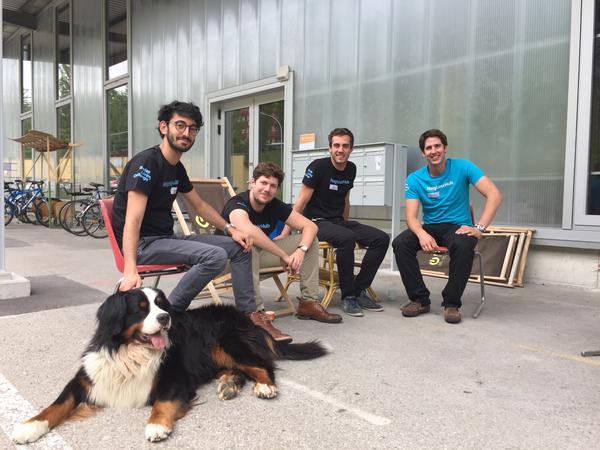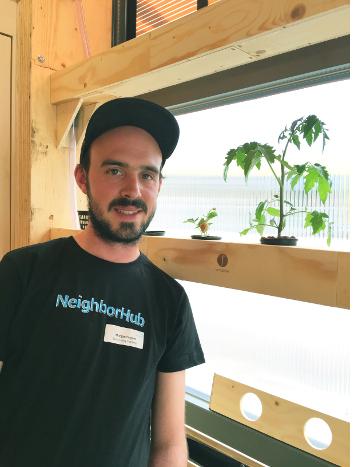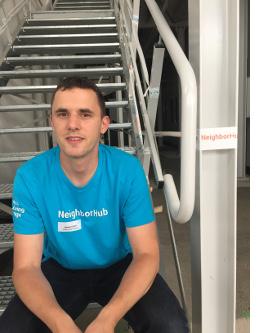Eight students tell us about their Solar Decathlon experience

© 2017 EPFL
Following the open days on 10 June, NeighborHub is now being dismantled in the Blue Hall in Fribourg, in preparation for shipping. Eight students tell us about their experience working on the self-sufficient house.
No fewer than two hundred fifty students have spent three years developing the energy-efficient house that will be Switzerland’s entry in the Solar Decathlon competition to be held in Denver in October. The ambitious and complex project brought together students from four schools: EPFL, the School of Engineering and Architecture of Fribourg, the Geneva School of Art and Design and the University of Fribourg. The synergies created, in terms of both skills and approaches, led to the creation of NeighborHub, a house aimed at increasing its inhabitants’ awareness of sustainable development.
As they undo the last screws and tidy up, eight students tell us about what this experience has meant to them.

Mathieu Farine, master's student in civil engineering
My takeaways
I'm proud to have shared a common sense of purpose with so many people. It was the project's community-related aspects that I really liked and that really motivated me. And the building work allowed me to put my studies into practice and challenge some of the things we had learned in class.
My role
I was involved in estimating costs, getting quotes for the construction work and determining the project's market potential. We’ve been trying to see how we can make the project attractive to buyers once the competition is over.
Yannick Fessler, master's student in civil engineering
My takeaways
I learned how to communicate with people working in other professions, especially building companies, and to understand their constraints and their way of thinking. I also found the media-relations aspect really interesting.
My role
I was involved in planning the work for Denver – we'll have only nine days to build our house on site, working from 7am until midnight. I was also involved in the logistics, particularly how to send the house to the States, how many shipping containers we'd need and how to work most efficiently once we're there.
Xavier Tendon, master's student in environmental sciences
My takeaways
Getting involved in the project made me think outside of my field. I had to make sure I understood the basics of thermodynamics, could use the architectural software Autocad and knew about Swiss construction standards.
My role
I was lucky enough to be part of the group that built the thermal solar panels for heating the plumbing water. We built the panels ourselves, so we were fully aligned with the project’s “workshop” approach, which seeks to ensure that this kind of know-how is transferred to the building’s inhabitants.
Alexandre Rychner, master's student in architecture
My takeaways
Wearing hardhat and boots, I was really lucky to see how in just a year’s time the project went from building plans to construction, from model to building site. I think the message behind NeighborHub is very clear: the project required people from different fields to come together and exchange ideas, and the aim of the finished product is also to promote closer relations between neighbors and encourage knowledge sharing.
My role
I was responsible for creating some of the files containing the specs needed to order materials based on the building plans. So I really got to practice using the software we learned about in class. After five years of studying architecture, I was also able to bring some ideas to the project.

Morgan Fargues, degree in environmental sciences
My takeaways
Developing the aquaponics, which involves a combination of cultivating plants and breeding a small number of fish, helped me deepen my knowledge of plants. We don't study this field directly in class. Aquaponics is an ideal way of growing your own fruit and vegetables in an urban setting without pesticides.
My role
I’m in charge of convincing US companies and associations to lend us plants in October for the building's green roof and our urban vegetable patch – we’re not allowed to take anything with us from here.

Samuel Cotture, degree in mechanical engineering
My takeaways
Involves in the first workshop of the project, I'm really proud to have been involved from start to finish. We began by creating an association with just a small number of people involved. It’s really gratifying to see how far we've come today, along with the media buzz and the positive feedback from the public.
My role
I'm involved in a lot of things, providing support to a number of teams. In addition to project management, I've been able to use my mechanical engineering skills for the energy and hydraulic sides of the building. I also helped develop the conception and dimension of the anti-fire system and developed a mecanichanical system of dry toilets.

Cléo Wiseman, degree in civil engineering
My takeaways
We had to design an innovative project in a tight timeframe, using existing technologies to create our utopia and learning how to compromise. There were some difficult moments, but I never lost my motivation. Working with the construction companies taught me a lot of things that will be useful in my career.
My role
In addition to project management, I was involved in developing the hot water production system, the plants and the sanitary facilities. I also learned the basics of plumbing.

Axelle Marchon, degree in architecture
My takeaways
I always wanted to specialize in sustainable architecture, so it was a real opportunity to be on both sides of the project, as both client and designer. We turned the crazy idea we came up three years ago into reality!
My role
I integrated a solar dryer into NeighborHub's architecture. It's built between two walls and makes it possible to dry clothes using the building's energy. I was also involved in creating the spec files for the contractors. To make sure the engineers understood my ideas, I had to learn to switch from 2D, which is often how we architects view things, to 3D.



